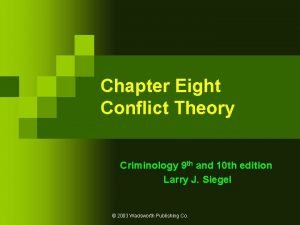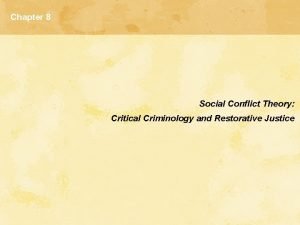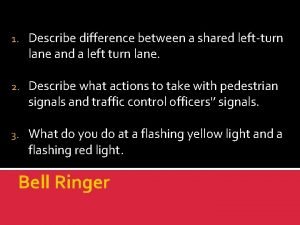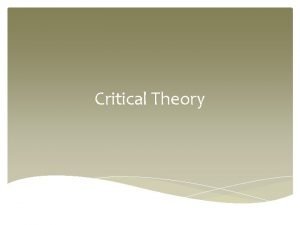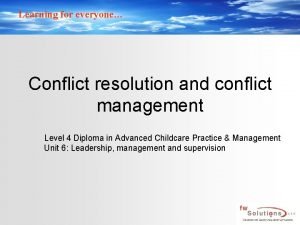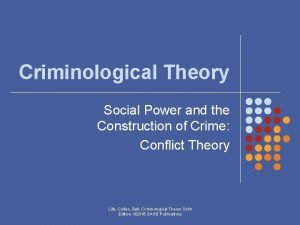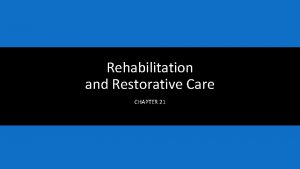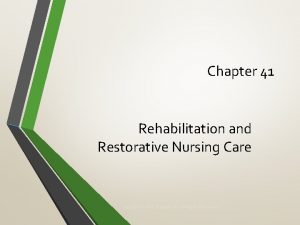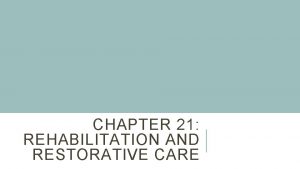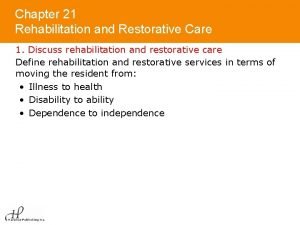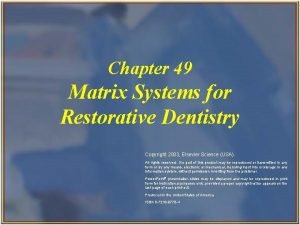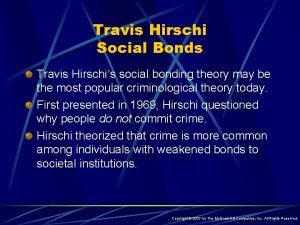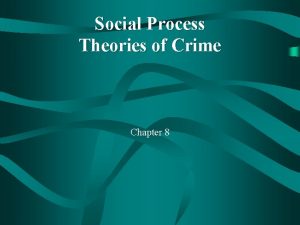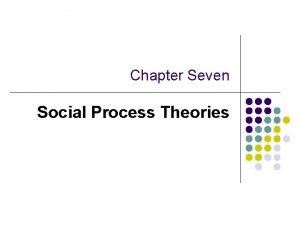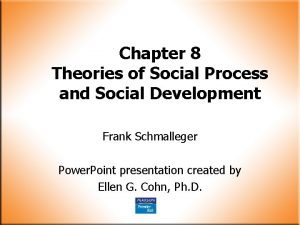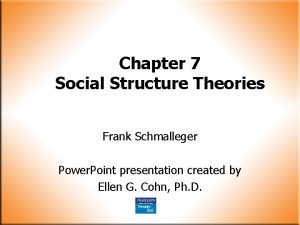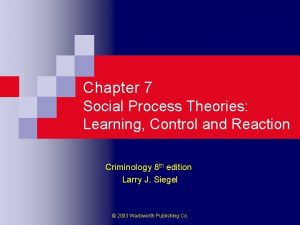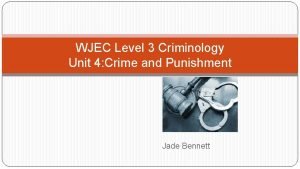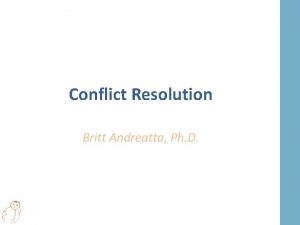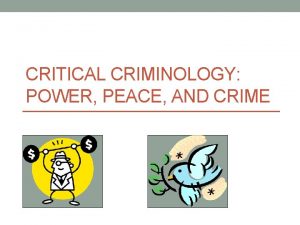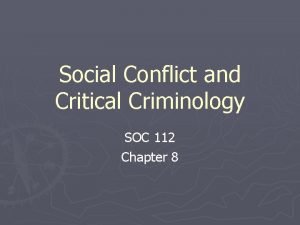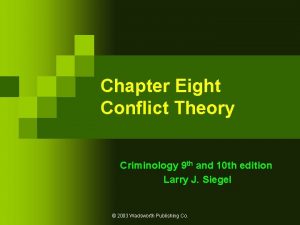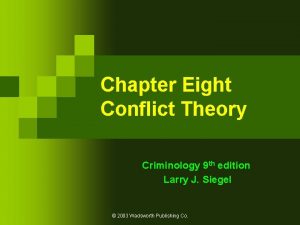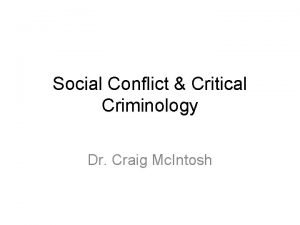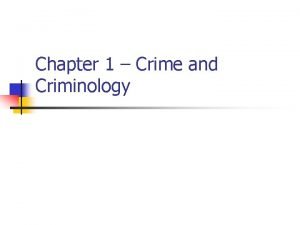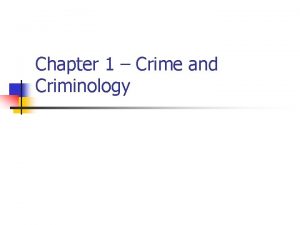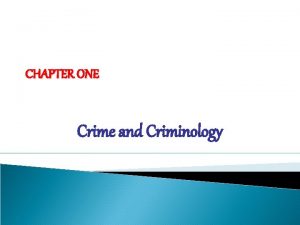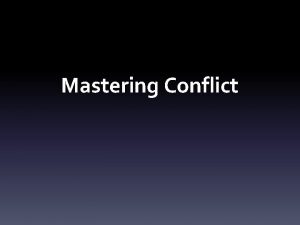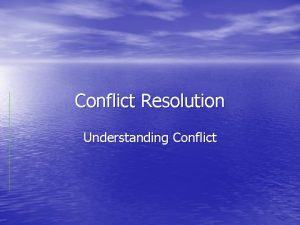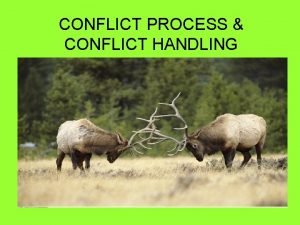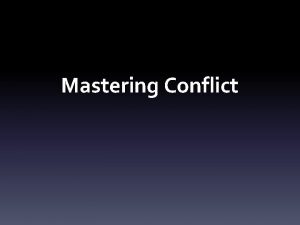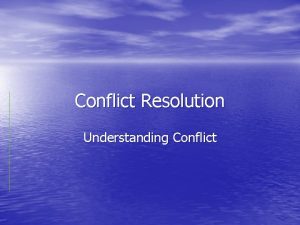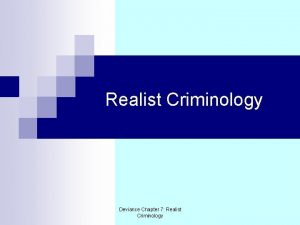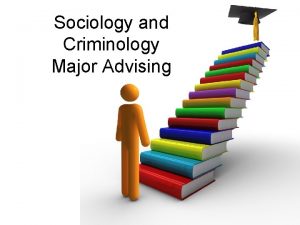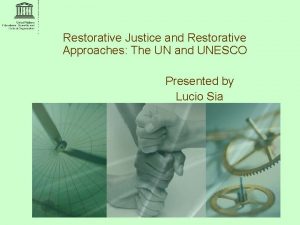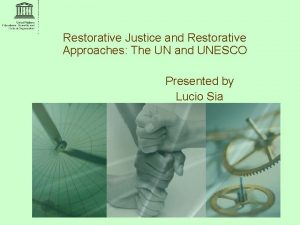Chapter Eight Social Conflict Critical Criminology and Restorative























- Slides: 23

Chapter Eight Social Conflict, Critical Criminology and Restorative Justice

Objectives l l l l l Be familiar with the concept of social conflict and how it shapes behavior Be able to discuss elements of conflict in the justice system Be familiar with the idea of critical criminology Be able to discuss the differences between structural and instrumental Marxism Know the various techniques of critical research Be able to discuss the term “left realism” Understand the concept of patriarchy Know what is meant by feminist criminology Be able to discuss peacemaking Understand the concept of restorative justice

Contemporary Critical Criminology l l Critical criminology views crime as a function of social conflict and economic rivalry It seeks to identify economic structures in society that control all humans It rejects the notion that the law is designed to maintain a tranquil, fair society and that criminals are malevolent people who wish to trample on the rights of others They consider the acts of racism, sexism, imperialism, unsafe working conditions, inadequate child care, substandard housing, pollution, and war-making as a tool of foreign policy, to be “true crimes. ”

Marxist Thought– Productive Forces and Productive Relations l l l Karl Marx focused his attention on the economic conditions perpetrated by the capitalists He identified the economic structures in society that control all human relations Production has two components: 1. productive forces 2. productive relations He proposed the notion that unequal distribution of power and wealth produce crime Crime develops as a result of social conflict

Creating a Critical Criminology l l Social thinkers began to show in our postindustrial, capitalist society the economic system invariably produces haves and havenots. Because economic competitiveness is the essence of capitalism, conflict increases and eventually destabilizes both social institutions and social groups.

How Critical Criminologists Define Crime l l l Crime is a political concept designed to protect the power and position of the upper classes at the expense of the poor Criminals are products of the society and its economic system To control crime, a society must remove the social conditions that promote crime

How Critical Criminologists View The Cause of Crime l l The key crime-producing element of modern corporate capitalism is the effort to increase surplus value To increase surplus value, workers can be made to toil harder for less pay As the rate of surplus value increases, more people are displaced from productive relationships Marginalization: as more people are placed outside the economic mainstream, a larger population is forced to live in areas conducive to crime


Globalization l l The process of creating a global economy through transnational markets and political and legal systems It began when large companies decided to establish themselves in foreign markets by adapting their products or services to the local culture

Instrumental vs. Structural Theory l l Instrumental theorists view criminal law and the criminal justice system as instruments for controlling the poor, have-not members of society. Structural theorists believe that the law is not the exclusive domain of the rich; rather, it is used to maintain the long-term interests of the capitalist system and control members of any class who threatens its existence.

Research on Critical Criminology l l l Critical thinkers believe that the research conducted by mainstream liberal and positivist criminologists is often designed to unmask weak, powerless members of society so they can be better dealt with by the legal system Rarely use standard social science methodologies use to test their views, more likely to examine historical trends and patterns rather than surveys and numbers Examples: racial profiling, police brutality, prosecution and sentencing disparities.

Emerging Forms of Critical Criminology l l l Left realism Critical Feminist Theory Peacemaking criminology

Left Realism l l Approach that sees crime as a function of relative deprivation under capitalism and favors pragmatic, community-based crime prevention and control Experiencing poverty in the midst of plenty creates discontent and breeds crime Discontent plus lack of political solution equal crime Community based efforts seem to hold the greatest promise of crime control

Critical Feminist Theory l l l Critical feminism: view gender inequality as stemming form the unequal power of men and women in a capitalist society. Patriarchy system developed in which men’s work was valued and women’s work was devalued. The dual exploitation of women within the household and in the labor market means that women produce far greater surplus value for capitalists than men.

Power-Control Theory l l The view that gender differences in crime are a function of economic power and parental control Girls are controlled more closely than boys in traditional male-dominated households and there is gender equity in contemporary egalitarian homes

Peacemaking Criminology l l l Approach that considers punitive crime control strategies to be counterproductive and favors the use of humanistic conflict resolution and mediation skills to prevent and control crime Offers a new approach to control crime Views the efforts of the state to punish and control as crime-encouraging rather than crimediscouraging

Critical Theory and Public Policy l l l Seek to reduce conflict and competition in society If conflict and competition in society could somehow be reduced, it is possible that crime rates would fall Reduce harsh punishment of offenders Peacemakers look for ways to bring law violators back to the community Has adopted nonviolent methods and applied them to what is known as restorative justice

The Concept of Restorative Justice l l l Using humanistic, non-punitive strategies to right wrongs and restore social harmony Encompasses a variety of programs and practice Requires that society address victim’s harms, and needs, holds offenders accountable to put right those harms, and involves victims, offenders, and communities in the process of healing

The Process of Restoration l l Crime is an offense against human relationships Victims and the community are central to justice processes The offender has personal responsibility to the victims and to the community The offender will develop improved competency and understanding

Restoration Programs l l l negotiation mediation consensus building peacemaking sentencing circles

Restorative Justice: Society and Justice System l l Community Schools Police Courts

Balanced and Restorative Justice (BARJ) l The justice system should give equal weight to: l l l Hold offenders accountability to victims, Provide competency development for offenders in the system, and Ensure community safety.

Concerns about Restorative Justice l l l Is it a political movement or a treatment process? Must be wary of cultural and social differences No single definition Difficult task to balance the needs of offenders with those of the victims Benefits may only work in the short term while ignoring long term treatment needs
 Critical semi critical and non critical instruments
Critical semi critical and non critical instruments Semi critical
Semi critical Conflict theory criminology
Conflict theory criminology Conflict theory criminology
Conflict theory criminology Plane shape
Plane shape What are the meanings of the eight shapes and eight colors
What are the meanings of the eight shapes and eight colors Critical theory in criminology
Critical theory in criminology Bell and harts eight causes of conflict
Bell and harts eight causes of conflict Conflict criminology
Conflict criminology Rehabilitation and restorative care chapter 21
Rehabilitation and restorative care chapter 21 Chapter 41 rehabilitation and restorative nursing care
Chapter 41 rehabilitation and restorative nursing care Chapter 21 rehabilitation and restorative care
Chapter 21 rehabilitation and restorative care What is the goal of rehabilitation chapter 21
What is the goal of rehabilitation chapter 21 Spot-welded band
Spot-welded band Chapter 49 matrix systems for restorative dentistry
Chapter 49 matrix systems for restorative dentistry Social bond theory by travis hirschi
Social bond theory by travis hirschi Matzas
Matzas Primary vs secondary deviance
Primary vs secondary deviance Social process theories criminology
Social process theories criminology Social structure theory in criminology
Social structure theory in criminology Social process theories criminology
Social process theories criminology External forms of social control
External forms of social control What is external conflict
What is external conflict What is conflict and conflict resolution?
What is conflict and conflict resolution?


